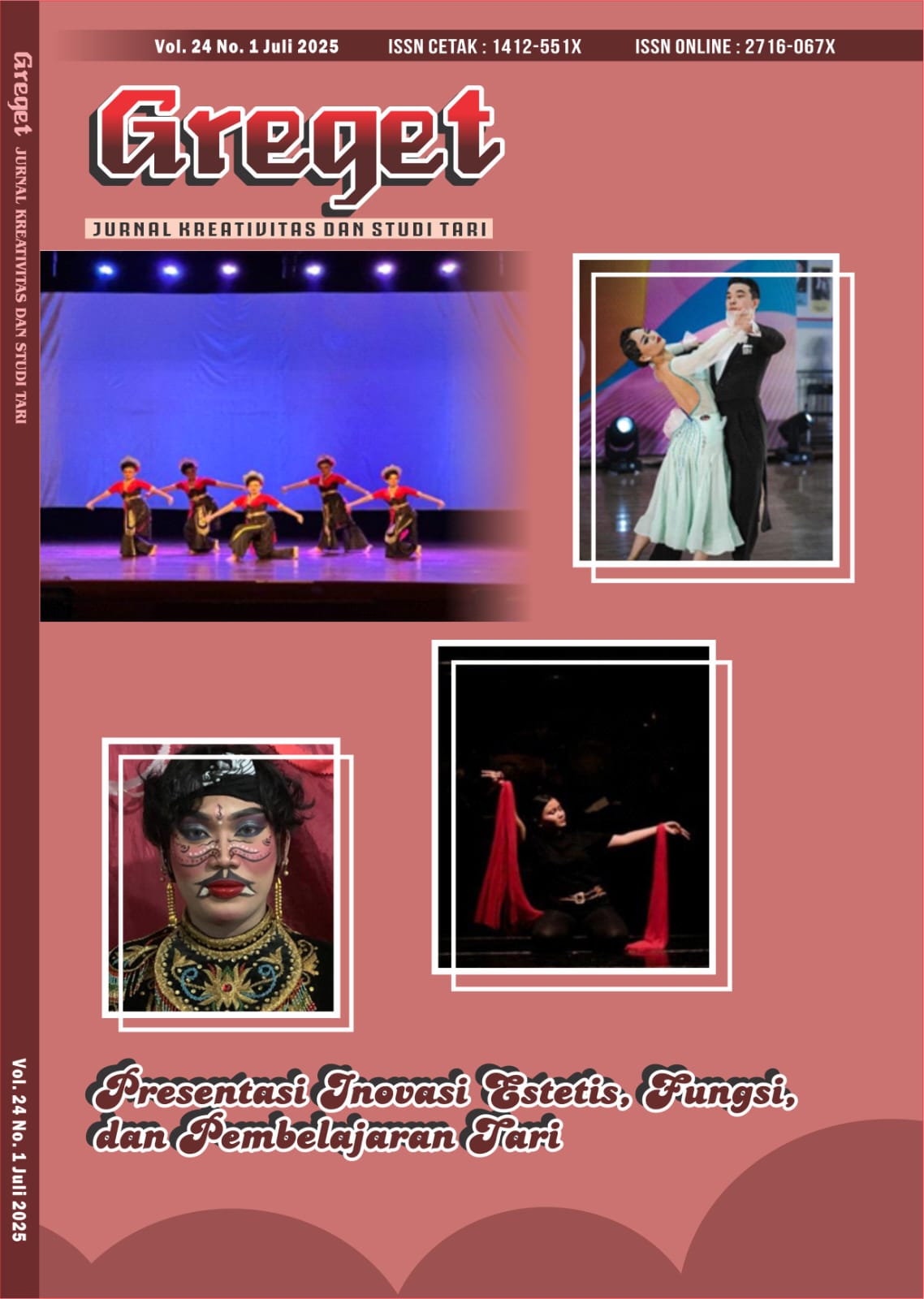NATYA GANDES: INOVASI REPERTOAR JAIPONGAN KEMASAN SENI WISATA Indonesia
Main Article Content
Abstract
The Natya Gandes dance is an innovative Jaipongan repertoire specifically created to cater to the demands of tourism-oriented performances in West Java. Developed through a practice-based research approach, this work preserves the essential structural components of traditional Jaipongan—bukaan, pencugan, nibakeun, and mincid. To appeal to a broader and more contemporary audience, Natya Gandes incorporates modern elements, including Zumba-inspired movements and digitally arranged traditional music. The title Natya Gandes symbolizes a graceful, energetic, and skilled female figure, reflecting the choreography’s expressive, interactive, and dynamic character. This article focuses on examining the conceptual framework underlying the choreography of Natya Gandes, offering a detailed analysis of its key components: movement vocabulary, spatial design, musical accompaniment, title and theme, genre and stylistic nature, performance method, number and gender of dancers, as well as makeup, costuming, and lighting. Ultimately, this choreographic innovation aims to enrich the traditional performing arts repertoire while simultaneously enhancing the appeal of West Javanese cultural heritage within the tourism sector.
Downloads
Article Details

This work is licensed under a Creative Commons Attribution-ShareAlike 4.0 International License.
Copyright
Authors who publish with GREGET agrees to the following terms:
- Authors retain copyright and grant the journal right of first publication with the work simultaneously licensed under a Creative Commons Attribution-ShareAlike 4.0 (CC BY-SA 4.0) that allows others to share the work with an acknowledgment of the work's authorship and initial publication in this journal.
- Authors are able to enter into separate, additional contractual arrangements for the non-exclusive distribution of the journal's published version of the work (e.g., post it to an institutional repository or publish it in a book), with an acknowledgment of its initial publication in this journal.
- Authors are permitted and encouraged to post their work online (e.g., in institutional repositories or on their website) prior to and during the submission process, as it can lead to productive exchanges, as well as earlier and greater citation of published work.
References
Andini, Gustari Tri & Nuriawati, Risa. (2023). Tari Jaipongan Gayana Karya Gondo di Klinik Tari Gondo Art Production. Jurnal Seni Makalangan, 10(1), 84-101. https://jurnal.isbi.ac.id/index.php/makalangan/article/view/2707
Astini, Ni Kadek RD. (2020). Proses Kreatif Penciptaan Karya Tari Janger Abhinaya di Tengah Era Pandemi. Geter, 3(2), 84-99. https://journal.unesa.ac.id/index.php/geter/article/view/14227
Az-zahra, Khairunnisa, Sumiati, Lilis & Azizah, Farah Nurul. (2024). Tari Kele: Sebuah Gagasan Kreatif Neng Peking. Jurnal Panggung, 34(3), 401-417. https://jurnal.isbi.ac.id/index.php/panggung/article/view/3561
Cahyana, Juz Tsani & MD, Slamet. (2025). Restrospeksi Penciptaan Karya Tari Slewah. Sitakara: Jurnal Pendidikan Seni dan Seni Budaya, 10(1), 105-118. https://jurnal.univpgripalembang.ac.id/index.php/sitakara/article/view/16982
Dewi, Septiana & Supendi, Eko. (2023). Proses Penciptaan Karya Tari Unbalanced. Greget: Jurnal Kreativitas dan Studi Tari, 22(2), 181-191. https://jurnal.isi-ska.ac.id/index.php/greget/article/view/5426
Hadi, Y.Sumandiyo. (2003). Aspek-aspek Dasar Koreografi Kelompok. Yogyakarta: Manthili.
Hadi, Y. Sumandiyo. (2012). Koreografi: Bentuk-Teknik-Isi. Yogyakarta: Cipta Media.
Lavender, Larry. (2000). Dancers Talking Dance Critical Evaluation in the Choreoghraphy.
Martiasyah, Agung Rizki & Ramlan, Lalan. (2024). Idha Jipo sebagai Penari Vokal dalam Pertunjukan Bajidoran di Kota Bandung. Jurnal Seni Makalangan, 11(1), 78-90. https://jurnal.isbi.ac.id/index.php/makalangan/article/view/3408
Merliana, Herly & Azizah, Farah Nurul. (2024). Kajian Estetika Tari Setra Sari Karya Gugum Gumbira. JPKS (Jurnal Pendidikan dan Kajian Seni), 9(1), 88-107. https://jurnal.untirta.ac.id/index.php/JPKS/article/view/24651
Nuriawati, Risa & Nalan, Arthur S. (2018). Kreativitas Gondo dalam Tari Jaipong. Jurnal Seni Makalangan, 5(2), 27-40. https://jurnal.isbi.ac.id/index.php/makalan gan/article/view/842
Putra, Bintang Hanggoro. (2012). Pengembangan Model Konservasi Kesenian Lokal sebagai Kemasan Seni Wisata di Kab. Semarang. Jurnal Harmonia, 12(12), 167-172.
Ramlan, Lalan & Jaja. (2019). Estetika Tari Réndéng Bojong Karya Gugum Gumbira. Jurnal Panggung, 29(4), 328-342. https://jurnal.isbi.ac.id/indeks.p%20hp/panggung/article/view/1048%20/651
Rosala, Dedi, dkk. (2018). Pencugan Ibing Penca Topeng Pendul Kabupaten Karawang. Jurnal Panggunig, 28(1), 16-32. https://jurnal.isbi.ac.id/index.php/panggung/article/view/411
Rusliana, Iyus. (2016). Tari Wayang: Khas Priangan Studi Kepenarian Tari Wayang. Bandung: STSI Bandung.
Sabekti, Endra & Wahyudi, Didik Bambang. (2020). Analisis Gerak Tari Merak Subal Karya S. Maridi pada Sanggar Soeryo Soemirat di Surakarta. Greget: Jurnal Kreativitas dan Studi Tari, 19(2), 116-124. https://jurnal.isi-ska.ac.id/index.php/greget/article/view/3455/pdf
Sari, Gigis Setia Puspita. (2024). Bentuk dan Proses Penciptaan Tari Betari Among Kitri. Greget: Jurnal Kreativitas dan Studi Tari, 23(2), 143-155. https://jurnal.isi-ska.ac.id/index.php/greget/article/view/6102
Turyati & Azizah, Farah Nurul. (2022). Kajian Struktur Tari Perang Centong dalam Ritual Ngasa Kampung Budaya Jalawastu Brebes. Jurnal Panggung, 3(4), 491-502. https://jurnal.isbi.ac.id/index.php/panggung/article/view/2302
Turyati & Alamsyah, Yosep. (2023). Proses Kreatif Penciptaan Tari Gandasari Gandawangi Sebagai Kemasan Seni Wisata. Prosidding: Transformasi dan Internalisasi Nilai-Nilai Seni Budaya Lokal dalam Konteks Kekinian. Bandung: Sunan Ambu Press.
Wijaya, Christianti Mediana & Handayani, Erni Wahyuning. (2019). Proses Kreatif Penciptaan Tari Suramadu Karya Diaztiarni di Sanggar Tydif Surabaya. Apron: Jurnal Pemikiran Seni Pertunjukan, 8(1), https://ejournal.unesa.ac.id/index.php/apron/article/view/30980
